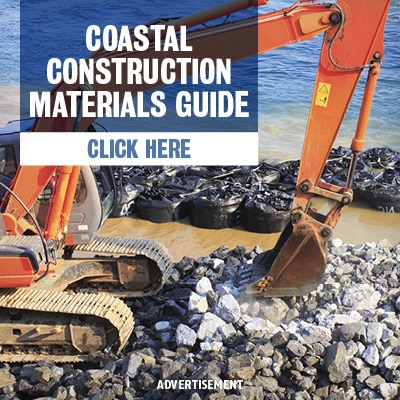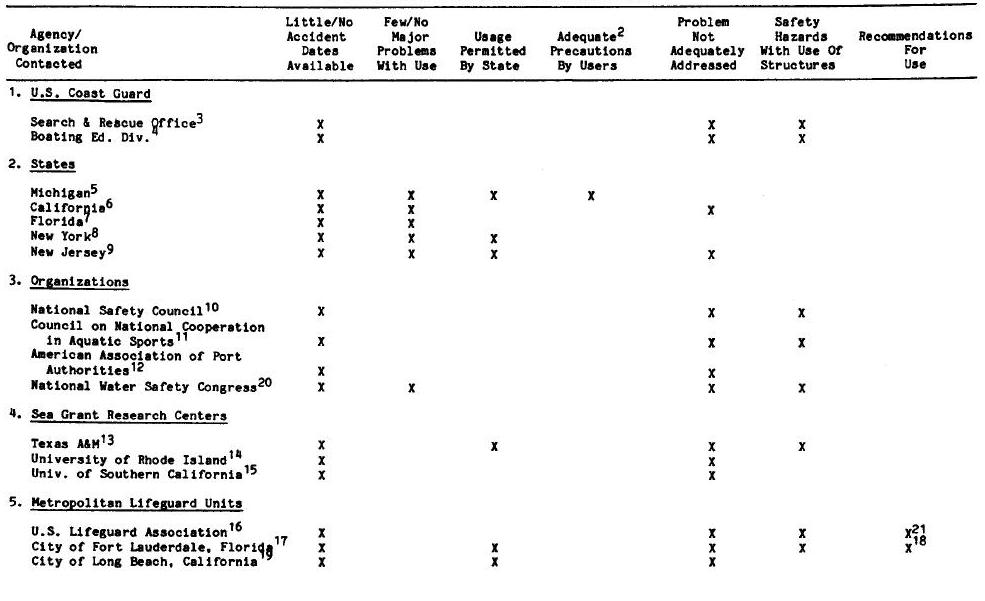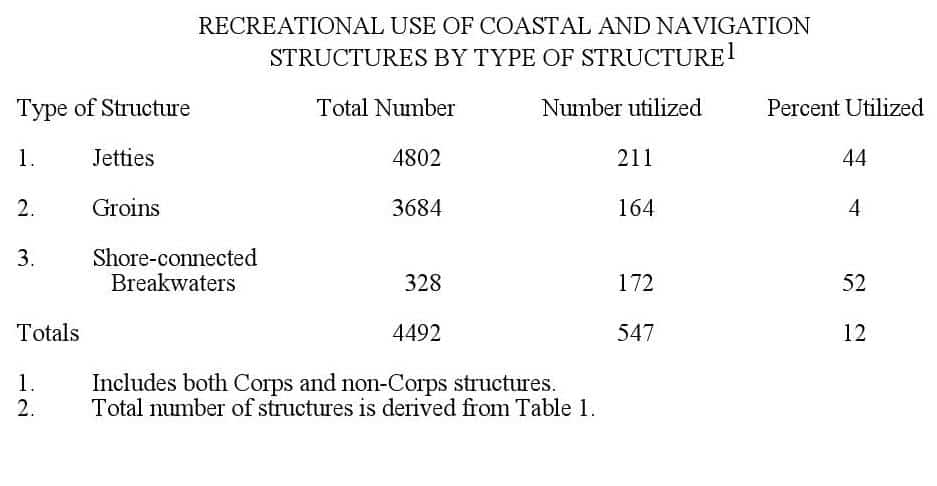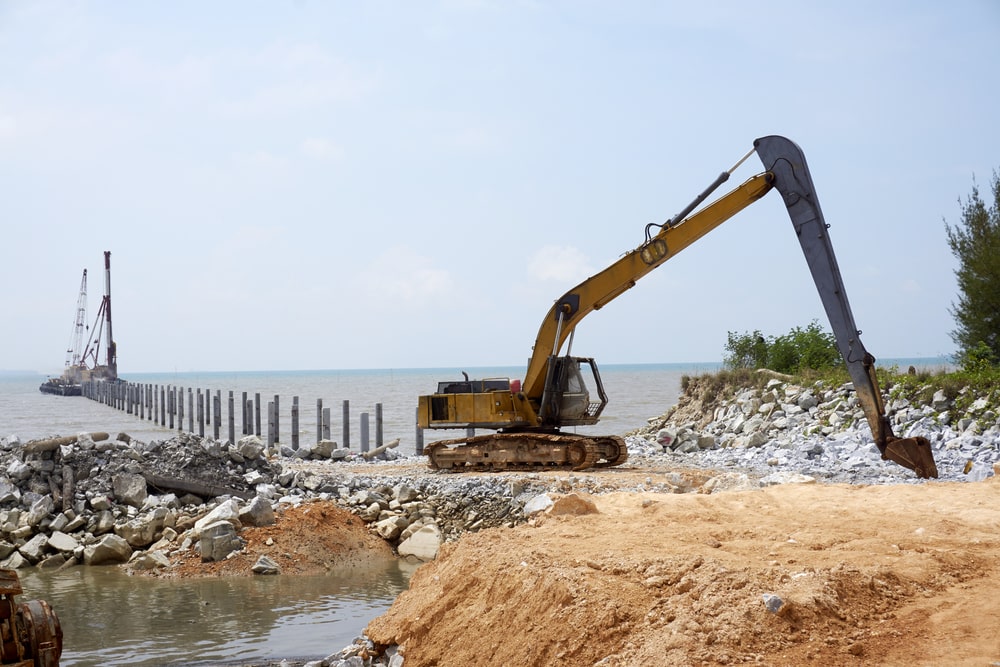Chapter 5 – Overviews, Visitation Statistics, Accidents, and Benefits
For a complete version of this document click here.
 PUBLIC USE OF U.S. ARMY CORPS OF ENGINEERS JETTIES, GROINS AND BREAKWATERS: OVERVIEWS, VISITATION STATISTICS, ACCIDENTS AND BENEFITS
PUBLIC USE OF U.S. ARMY CORPS OF ENGINEERS JETTIES, GROINS AND BREAKWATERS: OVERVIEWS, VISITATION STATISTICS, ACCIDENTS AND BENEFITS
In order to solicit a wide variety of views on the issue of public use of coastal and navigation structures, several officials outside the U.S. Army Corps of Engineers were contacted by telephone. They represent such diverse groups as the U.S. Coast guard, state marine safety officers, national and private safety councils, university sea grant programs, and lifeguard units in a few major cities (Table 5).
Most of the individuals contacted reported that, although the issue has at best only been casually addressed, and that although few, if any, meaningful statistics have been collected on accidents/fatalities associated with recreational use of groins, breakwaters and jetties, there appear to be no major problems with public use of these structures. However, conversations with members of metropolitan lifeguard staffs indicated gross underestimation of the safety hazards accompanying the use of these structures by the recreating public. These safety hazards include presence of rip currents near structures and slippery surfaces and the possibility of frequent overtopping.
Marine safety officers in Michigan, California, Florida, New York and New Jersey indicated that their respective state coastal authorities gave “silent consent” to the recreational use of jetties and shore-connected breakwaters. Although these same officials recognized the existence of potentially hazardous conditions during storms, all but one were in agreement about the benefits provided by these structures. Individuals especially benefiting from recreational opportunities afforded by jetties, etc., include members of society (poor, senior citizens) who without some type of public access would not have any occasion to engage in marine-related recreation. In several coastal areas of the United States with large amounts of shoreline privately owned, these coastal and navigation structures sometimes provide the only form of public access to the water.
Although representatives of the U.S. Coast Guard, university sea grant programs and organizations concerned with water safety indicated interest in the issue of public use of groins, jetties and breakwaters, due to the limited scope of their program areas and issue concerns, these officials were unable to provide much detailed information on the subject. The Search and Rescue Office of the U.S. coast Guard maintains files only on boating accidents and would not normally include jetty-related accidents unless collisions involving watercraft occurred on or near this structure. Organizations relating to water safety contacted in this study generally reported that public use of coastal and navigation structures is not considered a program priority. Texas A&M University was the only sea grant center reporting any data on this issue.

During telephone interviews, members of two metropolitan lifeguard units stressed the apparent lack of public awareness of potential dangers associated with public use of jetties, etc. While conceding that a total ban on recreational use of these structures is unrealistic and that the total number of accidents associated with these same structures is probably no greater than any other form of marine recreation, they nevertheless urged implementation of measures to prevent loss of life and injury to the public. Adequate signs and warning posters should be installed and frequently inspected to assure their continued emplacement. In this respect, both local as well as Corps responsibility should be upgraded. One of the lifeguards was of the opinion that the addition of handrails would encourage rather than discourage public use of these facilities. Further discussion of the recreational use of these facilities is expected to be included on the agenda at a national meeting of the U.S. Lifeguards Association.
Extent of Public Use of Jetties, Groins and Breakwaters for Recreational Purposes
Approximately 12 percent (5LI7) of all coastal and navigation structures are presently used by the public for fishing and related recreational activities (Tables 6 and 7). Over one-half of all shore-connected breakwaters (both Corps and non-Corps-maintained) as well as 44 percent (211) of all jetties serve as sites for seasonal recreation opportunities. However, since nearly all (95 percent) of the estimated 3700 groins are privately maintained, few are utilized by the general recreating public.
Table 8 presents a percentage breakdown of recreational use at both Corps-maintained and non-Corps-maintained jetties, groins and breakwaters. While the Corps of Engineers maintains only seven percent of all jetties, groins and shore-connected breakwaters, on a percentage utilization basis, recreational use of these structures accounts for about 58 percent of all such recreation (318 172), respectively.

Visitation Statistics/Intensity of Public Use at Corps and Non-Corps-Maintained Jetties, Groins and Breakwaters
At present, very little factual data is available concerning intensity of use of jetties, groins and breakwaters located in the coastal and Great Lakes areas of the United States. Only six Corps districts and one division (Baltimore, Buffalo, Seattle, Jacksonville, Mobile, Los Angeles and Pacific Ocean Division) out of a total of 21 districts responding to the questionnaire submitted any estimates of public visitation to these structures. Of the estimate of visitor days supplied by these districts, all but one were based on professional judgments rather than on official statistics. To date, only one study actually reporting usable visitation statistics at a navigation structure is available. A study prepared by scientists at the University of Southern California reported use intensity of .7 to 21.1 persons/100 meters of structure on jetties and breakwaters in the vicinity of Paolos Verdes, California (Ghazanshaishi, et al.). Since this usage coefficient was derived using data observed in one of the less popular recreation seasons of the year (November) and only using a “grab sample,” its applicability to other coastal structures may be of dubious value. The most popular recreation season reported was summer, accounting for 58 percent of all activities on these structures, followed by fall (22 percent) and spring (20 percent).
Accidents and Injuries Resulting from Public Use of Coastal and Navigation Structures
From our analysis of response data supplied to IWR by Corps districts on accidents and injuries resulting from use of jetties, etc., few, if any, generalized statements can be made concerning this issue. Few Corps districts actually maintain files on personal injuries at these structures. Local or state marine safety officials generally provide such information to appropriate Corps personnel. The following short discussion summarizes the limited (and perhaps somewhat ambiguous) data on the subject submitted by various Corps districts.
Over 80 percent of all Corps districts reported no information on number of injuries or accidents at jetties, groins or breakwaters in their districts. The largest number of accidents (4) occurred in the Detroit District, while files in the New Orleans and Seattle Districts and the Pacific Ocean Division offices indicate only one accident for each of these districts. Types of accidents included cuts (5), broken bones (2), drowning (3), and other (2). The majority of Corps respondents concluded that generally no single structure or type of structures have a higher incidence of accidents. In addition, combinations of factors rather than one single factor are usually responsible for injuries to the recreating public using local jetties and breakwaters. Severe weather conditions, in combination with certain types of structures and particular types of materials used in its construction, represent the most hazardous condition (slippery surfaces) for individuals engaged in recreation in these areas. The actions of waves on coastal structures can contribute significantly to the development of conditions potentially hazardous for members of the recreating public. Waves along with weather conditions are responsible for not only slippery surfaces but also for periodic drownings during storm surges or during other times of overtopping waters.
-
 SPW911 Sheet Pile Design Software
Rated 5.00 out of 5$150.00 – $599.99Price range: $150.00 through $599.99
SPW911 Sheet Pile Design Software
Rated 5.00 out of 5$150.00 – $599.99Price range: $150.00 through $599.99 -
 Sheet Pile Design (PDF Download)
Rated 5.00 out of 5$89.00
Sheet Pile Design (PDF Download)
Rated 5.00 out of 5$89.00 -
 Pile Driving (PDF Download)
$89.00
Pile Driving (PDF Download)
$89.00
-
 Marine Construction Volumes 1 & 2 (PDF Download)
$157.00
Marine Construction Volumes 1 & 2 (PDF Download)
$157.00
-
 Pile Driving (Book)
$89.00
Pile Driving (Book)
$89.00









